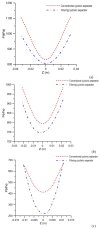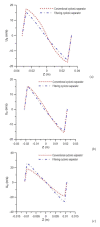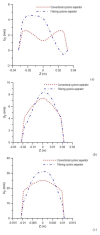Impact of Permeable Membrane on the Hydrocyclone Separation Performance for Oily Water Treatment
- PMID: 33217918
- PMCID: PMC7698712
- DOI: 10.3390/membranes10110350
Impact of Permeable Membrane on the Hydrocyclone Separation Performance for Oily Water Treatment
Abstract
In the oil industry and academy, the treatment of water contaminated with oil using conventional hydrocyclones and membranes has been an alternative to meet the requirements established by environmental control agencies. However, such equipment is not fully efficient in the treatment of much diluted oily water, with both presenting restrictions in their performance. In this sense, the present work proposes to study the separation process of oily water using a new configuration of hydrocyclone, equipped with a porous ceramic membrane in the conical part's wall (filtering hydrocyclone). For the theoretical study, a Eulerian-Eulerian approach was applied to solve the mass and momentum conservation equations, and the turbulence model, using the computational fluid dynamics technique. The results of the velocity, pressure and volumetric fraction of the involved phases, and the separation performance of the hydrocyclone, are presented, analyzed, and compared with those obtained with a conventional hydrocyclone. The results confirmed the high potential of the proposed equipment to be used in the separation of the water and oil mixture.
Keywords: Ansys software CFX®; ceramic membrane; hydrocyclone; multiphase flow; water/oil separation.
Conflict of interest statement
The authors declare no conflict of interest.
Figures












References
-
- Vieira L.G.M. Ph.D. Thesis. Federal University of Uberlândia; Uberlândia, Brazil: 2006. Optimization of Separation Processes in Filtering Hydrocyclones. (In Portuguese)
-
- Farias F.P.M., Lima A.G.B., Neto S.R.F. Influence of the cyclone’s lower outlet duct used as a dryer: Modeling and simulation; Proceedings of the XVII Brazilian Congress of Chemical Engineering; Recife, Brazil. 14–17 September 2008; (In Portuguese)
-
- Farias F.P.M., Souza J.S., Lima W.C.P.B., Mâcedo A.C., Neto S.R.F., Lima A.G.B. Influence of Geometric Parameters of the Hydrocyclone and Sand Concentration on the Water/Sand/Heavy-Oil Separation Process: Modeling and Simulation. Int. J. Multiphysics. 2011;5:187–202. doi: 10.1260/1750-9548.5.3.187. - DOI
-
- Barbosa E.S. Ph.D. Thesis. Federal University of Campina Grande; Campina Grande, Brazil: 2011. Geometrical and Hydrodynamic Aspects of a Hydrocyclone in the Separation Process of Multiphase Systems: Application to the Oil Industry. (In Portuguese)
-
- Luna F.D.T. Master’s Thesis. Federal University of Campina Grande; Campina Grande, Brazil: 2014. Numerical Study of the Separation Process of a Two-Phase System in a Cyclonic Separator. (In Portuguese)
LinkOut - more resources
Full Text Sources

